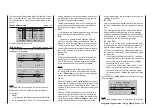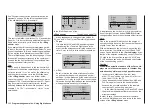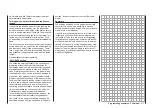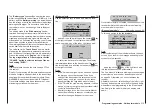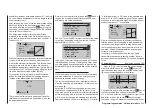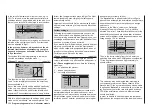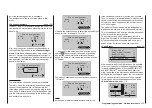
316 Programming examples - F3A model
»Free mixers«
… accordingly.
The ailerons are extended as landing assistance
depending on the position of the throttle stick, start-
ing from approximately half throttle toward idle. The
further the stick is moved toward idle, the more the ai-
lerons deflect upward. Just the opposite applies when
“throttling”; the ailerons are retracted again in order to
prevent a sudden rise of the model.
In order to prevent the model from climbing with the
aileron landing flaps extended, the elevator must be
mixed in somewhat.
For this purpose, set the two linear mixers shown
in the following display. The activation of the mixers
takes place with one and the same switch, such as
“15”, to which both mixers must be assigned with
identical switching direction.
ty
fr
to
M1
M2
M3
C1
5
C1
EL
M4
M5
??
??
??
??
??
??
15
15
Then switch to the second respective display screen
in order to adjust the respective mixing degrees. In
both cases the mixer neutral point is at the C1 control
center.
Enter 0 % above the control center after selection of
the ASY field for both mixers and below the control
center toward idle for:
MIX 1:
-60 % … -80 % and
MIX 2:
-5 % … -10 %.
Example Linear MIX 1:
L.Mix 1
0%
0%
Offset
ASY
SYM
C1
5
Mix input
–30%
With this, the base setup model of an F3A model is
concluded.
Compensation of model-specific errors
Unfortunately, there are nearly always minor model-
specific “errors” through the mixers of a computer
remote control which must be compensated for. How-
ever, before you begin with these settings, it should
be ensured that the model is faultlessly constructed,
optimally balanced over the longitudinal and trans-
verse axes and the down thrust and side thrust are
correct.
Influence of longitudinal and transverse axes by
the rudder
The actuation of the rudder often influences the be-
havior of the longitudinal and transverse axes. This is
particularly disruptive in so-called knife-edge flying,
in which the lift of the model with the rudder deflected
should be created by the fuselage alone. In the pro-
cess, the model can rotate and change directions as
though it were controlled with the ailerons and eleva-
tor. Therefore, a correction over the transverse axis
(elevator) and/or the longitudinal axis (ailerons) must
be made, if applicable.
This can also be done easily with the »Free mixers«
available in the
mc-16
HoTT or
mc-20
HoTT sys-
tem. For example, if the model drifts away to the right
over the longitudinal axis with the rudder extended in
knife-edge flying, the aileron can be deflected slightly
to the left with the mixer. Changes in direction over
the transverse axis can be performed analogously
with a mixer on the elevator:
• Correction over the transverse axis (elevator)
Linear MIX 3: “RU
EL”
Asymmetric setting. The appropriate values must
be tested in flight.
• Correction over the longitudinal axis (aileron)
Linear MIX 4: “RU
AI”
Asymmetric setting. The appropriate values must
be tested in flight.
Relatively small mixer values are usually sufficient
in this case, the range lies below 10 %, but can vary
from model to model. With the use of curve mixers,
the mix ratios can be adapted even more precisely
to the corresponding throw of the rudder. Again, no
values are indicated for this, because this would be
model-specific.
Vertical ascent and descent
Some models have a tendency to deviate from the
ideal line in vertical ascents and descents.
In order to compensate for this, it is necessary to
have a center position of the elevator dependent on
the throttle stick position. If, for example, the model
begins to hold off on its own in the vertical descent
with a throttled motor, some elevator must be mixed
in at this throttle position.
For this purpose, program a free mixer “C1
EL”.
The corresponding mixer values are normally under
5 % and must also be tested in flight.
Turning away over the longitudinal axis in idle
If the throttle is reduced, the model may begin to turn
away over the longitudinal axis in idle. This can be
counteracted with the aileron.
However, the more elegant solution is to correct this
effect with a free mixer “C1
AL”.
The input values here are usually very low (approx.
3 %) and the settings should be made in calm wea-
ther. It often suffices to only use the mixer between
Содержание HoTT MC-16 Series
Страница 1: ...Programming Manual mc 16 mc 20 HoTT 1 en mc 16 mc 20...
Страница 27: ...27 For your notes...
Страница 53: ...53 For your notes...
Страница 61: ...61 For your notes...
Страница 65: ...65 For your notes...
Страница 71: ...71 For your notes...
Страница 103: ...103 For your notes...
Страница 107: ...107 For your notes...
Страница 111: ...111 For your notes...
Страница 133: ...133 Program description Dual Rate Expo Winged models Set the Expo values as necessary in the same man ner...
Страница 137: ...137 Program description Dual Rate Expo Helicopter models Set the Expo values as necessary in the same man ner...
Страница 155: ...155 For your notes...
Страница 165: ...165 For your notes...
Страница 201: ...201 For your notes...
Страница 229: ...229 For your notes...
Страница 231: ...231 For your notes...
Страница 261: ...261 For your notes...
Страница 265: ...265 For your notes...
Страница 301: ...301 For your notes...
Страница 327: ...327 For your notes...
Страница 328: ...328 For your notes...


